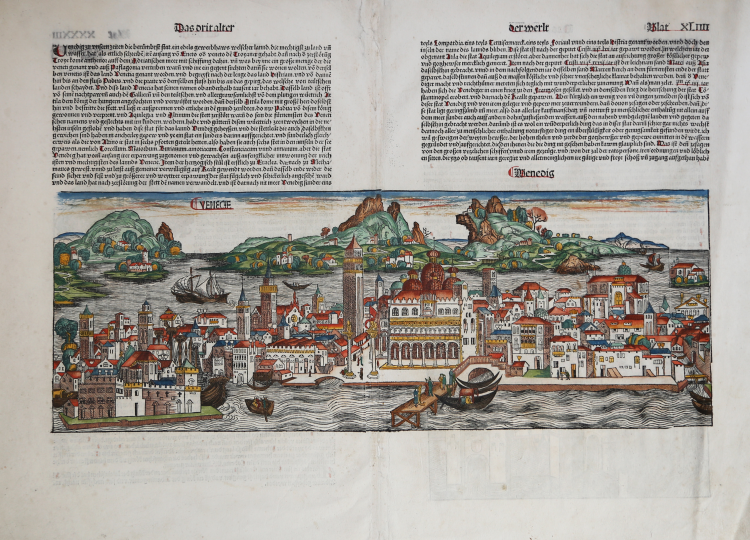




| Reference: | S39267 |
| Author | Hartmann SCHEDEL |
| Year: | 1493 |
| Zone: | Venice |
| Printed: | Nurnberg |
| Measures: | 620 x 150 mm |



| Reference: | S39267 |
| Author | Hartmann SCHEDEL |
| Year: | 1493 |
| Zone: | Venice |
| Printed: | Nurnberg |
| Measures: | 620 x 150 mm |
Panormic view of Venice, in a page with text about the history of the city.
On the verso: texts with portraits of Homer and the genealogy of the Welsh kings; unilateral view of Padua with text to the city.
From Liber Cronicarum, German edition.
Schedel's monumental Liber Cronicarum was “one of the most extraordinary works ever produced” The woodblock cutters were Michael Wolgemut, the well-known teacher of Albrecht Dürer, and his stepson Wilhelm Pleydenwurff.
Wohlgemut was Albrecht Dürer’s tutor between 1486-90 and recent scholarship has shown, Albrecht Dürer may also have collaborated, since some of the cuts bear a remarkably close resemblance to the Apocalypse illustrations. The printing was carried out under the supervision of the great scholar-printer Anton Koberger, whose printing were famous throughout Europe.
Woodcut, fine hand colour, otherwise in good condition.
Hartmann SCHEDEL (Norimberga 1440 - ivi 1514)
|
The medical doctor and humanist Hartmann Schedel, grew up in Nuremberg and first studied liberal art in Leipzig. In 1463 he went to Padua together with the humanist Petrus Luder, to study medicine, Italian, Greek and Hebrew. In 1466 he returned to Nuremberg as a medical doctor and settled as the Nuremberg town doctor. He was a prominent member of the Nuremberg circle of humanists around Pirckheimer, Hieronymus Münster and Konrad Celtis. His comprehensive private library was among the most important of his time, not only because of the books themselves, but also because of its numerous prints, miniatures and graphic sheets, which Schedel used to add to his books. Hartmann Schedel became famous for a world chronicle entitled 'Schedelsche Weltchronik' in his honor.
It is a world history containing humanist historical articles, and was published in Latin and German by Anton Koberger in Nuremberg in 1493. It was known as the largest undertaking in the book-making industry of that time and with its over 1800 woodcuts is one of the most richly illustrated incunables ever made. The high-quality artistic woodcuts were made by the German painter and woodcutter Wilhelm Pleydenwurff and his father-in-law Michael Wolgemuth in whose Nuremberg workshop Albrecht Dürer was an apprentice until late 1489.
|
Hartmann SCHEDEL (Norimberga 1440 - ivi 1514)
|
The medical doctor and humanist Hartmann Schedel, grew up in Nuremberg and first studied liberal art in Leipzig. In 1463 he went to Padua together with the humanist Petrus Luder, to study medicine, Italian, Greek and Hebrew. In 1466 he returned to Nuremberg as a medical doctor and settled as the Nuremberg town doctor. He was a prominent member of the Nuremberg circle of humanists around Pirckheimer, Hieronymus Münster and Konrad Celtis. His comprehensive private library was among the most important of his time, not only because of the books themselves, but also because of its numerous prints, miniatures and graphic sheets, which Schedel used to add to his books. Hartmann Schedel became famous for a world chronicle entitled 'Schedelsche Weltchronik' in his honor.
It is a world history containing humanist historical articles, and was published in Latin and German by Anton Koberger in Nuremberg in 1493. It was known as the largest undertaking in the book-making industry of that time and with its over 1800 woodcuts is one of the most richly illustrated incunables ever made. The high-quality artistic woodcuts were made by the German painter and woodcutter Wilhelm Pleydenwurff and his father-in-law Michael Wolgemuth in whose Nuremberg workshop Albrecht Dürer was an apprentice until late 1489.
|